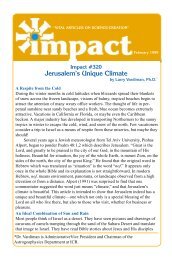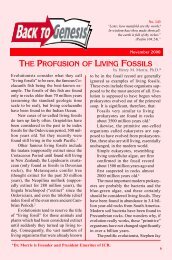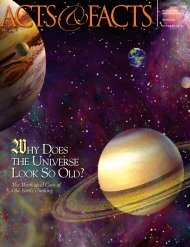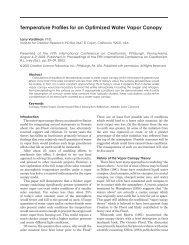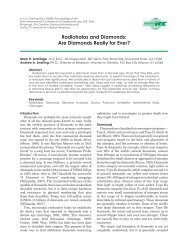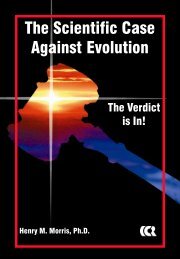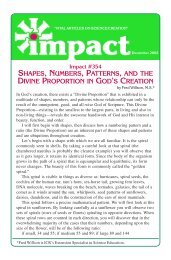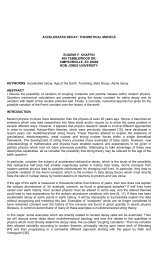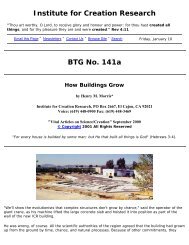Download September 2008 PDF - The Institute for Creation Research
Download September 2008 PDF - The Institute for Creation Research
Download September 2008 PDF - The Institute for Creation Research
Create successful ePaper yourself
Turn your PDF publications into a flip-book with our unique Google optimized e-Paper software.
This discovery marked the “beginning ofa new era of genetics,” starting an avalanche ofresearch in molecular genetics that opened widethe route to answering many major questionsin cell biology and biochemistry. 1 <strong>The</strong> studyareas affected by Arber’s discovery include solvingthe basic problem of cell differentiation andcontrol, and even the cell repair mechanisms. 1Born on June 3, 1929, in Switzerland,Werner Arber earned his Ph.D. in biophysicsfrom the University of Geneva in 1958. In hiscareer Arber was a professor at several universities,including the University of Southern Cali<strong>for</strong>niaand the University of Basel. 2 Much of hisresearch was directly related to evolution, and<strong>for</strong> this reason his conclusions in this area areof considerable interest.An Intelligent Design SupporterAfter a lifetime of research, Arber summarizedhis main conclusion about intelligentdesign (ID) in the following words:Although a biologist, I must confess I donot understand how life came about....Iconsider that life only starts at the levelof a functional cell. <strong>The</strong> most primitivecells may require at least several hundreddifferent specific biological macro-molecules.How such already quite complexstructures may have come together, remainsa mystery to me. <strong>The</strong> possibility ofthe existence of a Creator, of God, representsto me a satisfactory solution to thisproblem. 3He concluded that religion is importantto help humans cope not only with the problemof biological origins, but also with the questionsthat we all encounter in life, noting that someideologies “may take the place of a religion butscience cannot, although some people tend toclaim that it does.” 3 Arber wrote that his beliefin God “helped me to master many questionsin life; it guides me in critical situations,” and“Although a biologist, I mustconfess I do not understandhow life came about....<strong>The</strong>possibility of the existence ofa Creator, of God, representsto me a satisfactory solutionto this problem.”his ID conclusions were “confirmed” by hisresearch into the “beauty of the functioning ofthe living world.” 3Arber conducted extensive scientificresearch in genetics, evolution, and related areas.In his Nobel Prize autobiography, Arberdescribed his research as long but fruitless attemptsto document macroevolution with experimentalevidence. For this reason, he wrotethat much of his work in this area remainslargely unpublished.One could expect that mutations affectingthe part of the enzymes responsible <strong>for</strong>recognition of the specificity site on theDNA might result in new members of thefamily, recognizing new specificity sites onDNA. We have in vain spent much time insearch <strong>for</strong> such evolutionary changes bothafter mutagenization and after recombinationbetween two members of the samefamily of [bacteria]. 4Arber’s findings have been confirmedby many other scientists, such as Bullas et al. 5<strong>The</strong> most recent replication is by Lenski et al,who evaluated the changes in over 30,000 generationsof E. coli, concluding that millions ofmutations and trillions of cells were needed toproduce the estimated two to three mutationsrequired to allow cells to bring citrate into thecell under oxic conditions. 6 This correspondswith Michael Behe’s deductions that if onemutation is required to confer some advantageto an organism, this event is likely; if two arerequired, the likelihood is far less; but if threeor more are required, the probability rapidlygrows exponentially worse, from very improbableto impossible. Evolution by mutations <strong>for</strong>this reason has very clear limits. 7Arber also found evidence of a designedsystem that produces much genetic variety inbacteria and other organisms. One of the reasonshe came to doubt neo-Darwinism is thefact that life contains “the presence of genes,the actions of which are more often destructivethan useful” to evolution, a fact that Dr. Arberconcluded would be “puzzling” if orthodoxevolution were true. 8He stated that “the deeper we penetratein the studies of genetic exchange the more wediscover a multitude of mechanisms” involvedin human genetics that falsify the mutationplus natural selection core of macroevolution. 9Some of these factors act as promoters or to setlimits on genetic factors, and some do both.Arber once wrote that because of its “highlyaleatoric [random] nature, biological evolutionis often considered to be mainly the resultof accumulated errors,” but because biologicalevolution was given “great importance withrespect to the long-term maintenance of lifeon the planet…it is not likely nor conceptuallysatisfactory that biological evolution could bebased uniquely on mistakes.” 10Regarding major evolutionary questions,such as the origin of the in<strong>for</strong>mation required <strong>for</strong>natural selection, Arbor wrote in his Nobel Prizespeech that the answers so far proposed are oftentrivial or avoid the major questions facing Darwinism.He gave the example of using meaninglessphrases such as “evolutionary driving <strong>for</strong>ces”to explain how life evolved. As Arbor wrote, theclaim that “more intensive research is needed tounderstand the apparent complexity of nature”is actually an admission of ignorance about theorigin of complexity in the living natural world. 9SEPTEMBER <strong>2008</strong> • ACTS&FACTS11



